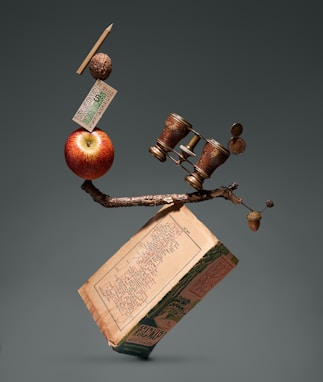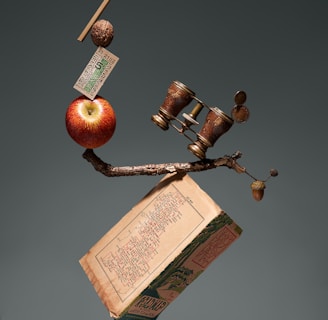Writing Beyond Words: Incorporating Visual Storytelling
Bibliotheca Exotica
4 min read


Introduction
Welcome to the world of writing beyond words! In this blog post, we will explore how writers can incorporate visual storytelling elements to enhance their narratives. By leveraging illustrations, typography, and layout, writers can create a more immersive and engaging experience for their readers. We will delve into the art of collaborating with artists, understanding the interplay of text and image, and using visuals to complement and enrich storytelling. So, let's dive in!
The Power of Visual Storytelling
Visual storytelling goes beyond the written word, allowing writers to communicate ideas, emotions, and messages in a more impactful and memorable way. By incorporating visual elements, writers can create a multi-dimensional experience for their readers, capturing their attention and evoking a deeper connection.
Here are some ways writers can harness the power of visual storytelling:
1. Illustrations
Illustrations are a powerful tool for conveying emotions, setting the scene, and bringing characters to life. Collaborating with talented illustrators can add a new dimension to your storytelling. When working with an illustrator, it's essential to communicate your vision clearly, providing them with detailed descriptions and references. By combining your words with their artistic interpretation, you can create a visually captivating narrative.
Tip: Consider the style and tone of your story when selecting an illustrator. The illustrations should align with the overall theme and atmosphere you want to convey.
2. Typography
Typography plays a crucial role in visual storytelling. The choice of fonts, sizes, and styles can enhance the mood and tone of your narrative. Experimenting with typography can help you create a unique and memorable reading experience. For example, using bold and dramatic fonts can emphasize important moments or dialogue, while elegant and flowing fonts can evoke a sense of romance or nostalgia.
Tip: Ensure that the typography is legible and complements the overall design. Avoid using too many different fonts, as it can create a cluttered and confusing reading experience.
3. Layout
The layout of your text and visuals can significantly impact the reader's engagement. A well-designed layout guides the reader's eye, leading them through the story seamlessly. Consider the placement of illustrations, text, and white space to create a balanced and visually appealing composition.
Tip: Experiment with different layouts to find the one that best complements your narrative. Remember to leave room for illustrations to breathe and allow the text to flow naturally.
Collaborating with Artists
Collaborating with artists is a wonderful opportunity to bring your story to life visually. Here are some tips for successful collaborations:
1. Clearly Communicate Your Vision
When working with artists, it's crucial to communicate your vision effectively. Provide them with a detailed brief that includes character descriptions, scene settings, and any specific visual elements you envision. Sharing visual references can also help convey your ideas more clearly.
2. Foster an Open Dialogue
Encourage collaboration and open communication with the artist. Be open to their suggestions and ideas, as they bring their unique perspective and expertise to the table. A collaborative approach can lead to unexpected and exciting visual interpretations.
3. Set Clear Deadlines and Expectations
Establish clear deadlines and expectations from the beginning of the collaboration. This ensures that both parties are on the same page and helps maintain a smooth workflow. Regular check-ins and updates can also help address any concerns or revisions along the way.
The Interplay of Text and Image
Understanding the interplay between text and image is essential for effective visual storytelling. Here are some tips to strike the right balance:
1. Complementing the Narrative
Visuals should enhance and complement the narrative, not overpower it. Ensure that the images you choose align with the tone, mood, and themes of your story. The visuals should add depth and richness to the text, providing additional layers of meaning.
2. Creating Visual Cues
Visual cues can guide the reader's understanding and interpretation of the text. Use illustrations strategically to highlight key moments, emotions, or important plot points. These visual cues can help readers connect with the story on a deeper level.
3. Balancing Text and Image
Achieving a harmonious balance between text and image is crucial. Avoid overcrowding the page with too much text or overwhelming the visuals with an excessive amount of detail. Find a balance that allows both elements to shine and work together seamlessly.
Using Visuals to Enrich Narrative
Visuals can enrich your narrative in various ways. Here are some ideas to incorporate visuals effectively:
1. Setting the Scene
Use illustrations to set the scene and transport readers to the world of your story. A well-crafted visual can instantly immerse readers in the environment, making them feel like they are a part of the narrative.
2. Conveying Emotions
Visuals have the power to evoke emotions in ways that words alone may struggle to achieve. Use illustrations to capture the emotions of your characters or to create a particular atmosphere. The right visual can make readers feel joy, sadness, excitement, or fear.
3. Depicting Characters
Illustrations can bring your characters to life, allowing readers to visualize them as they read. Collaborate with illustrators to create compelling character designs that resonate with your readers.
4. Enhancing Symbolism
Visuals can enhance the symbolism and deeper meaning within your narrative. Use illustrations strategically to represent abstract concepts or to foreshadow events. These visual cues can add layers of depth to your storytelling.
Conclusion
Incorporating visual storytelling elements into your writing can elevate your narratives to new heights. By collaborating with artists, understanding the interplay of text and image, and using visuals to enrich your storytelling, you can create a more immersive and engaging experience for your readers. So, embrace the power of visual storytelling and let your words come alive through the magic of visuals!

